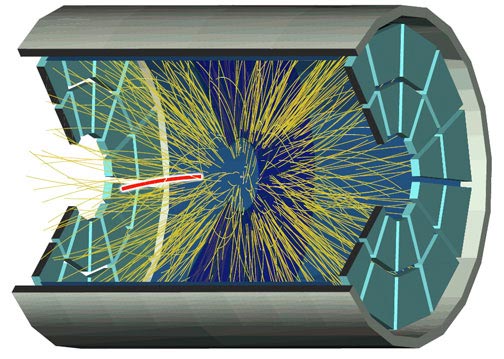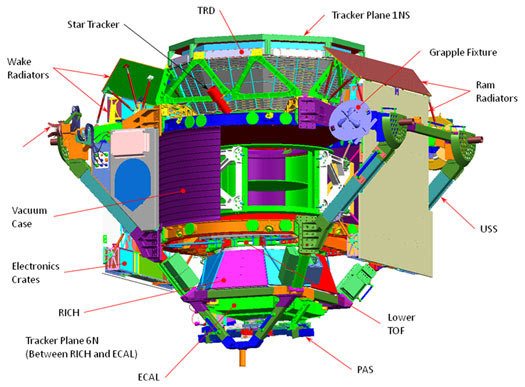Antimatter is the alter ego of normal
matter, and one of my life-long special interests. A U.S. lab has
announced a major new discovery, and NASA is about to launch a bold
(some say fool-hardy) search for antimatter in space.
What is antimatter?
For each type of particle of normal
matter, nature provides a corresponding type of antiparticle—electrons
are matched by antielectrons, and charmed quarks by anti-charmed quarks,
etc. Antielectrons have the same mass as electrons but all their other
properties, such as electric charge, are the opposite.
When a particle meets its antiparticle
all their properties exactly cancel one another except their mass
energies. The result is cataclysmic—total annihilation. Normally,
“annihilation” means destruction with some remaining trace of what
existed before. But particle/antiparticle annihilation goes far beyond
that. The mass energies may be converted into light, leaving no residue
of any sort, no trace that either particle or antiparticle ever existed.
The intriguing mystery of antimatter is
that virtually all of it has disappeared from our universe without all
of the matter also disappearing. It’s well accepted that when our
universe came into existence, it must have contained equal amounts of
matter and antimatter, else it could not have emerged from nothing. When
an antimatter particle annihilates, it takes a particle of matter with
it into oblivion. So it seems that if all the antimatter disappeared
through annihilation there would be no matter left as well—no stars, no
planets, and no us. But nature provides an “out” that made life
possible. Unlike every other force of nature, the lowly weak force
treats matter and antimatter somewhat differently, as my Ph.D. thesis
experiment demonstrated. This small difference allowed a small excess of
matter to accumulate just after the Big Bang. Within the first one
second, every one billion particles of antimatter were outnumbered by
one billion and one particles of normal
matter. The billions annihilated, leaving the one extra particle of
matter, from which everything we see today is made.
Science cannot yet explain why this
imbalance had this exact value (one in a billion), but we do know that
if it had been even slightly more or slightly less, life would have been
impossible. This is one of the captivating mysteries of our existence
and a compelling research subject.
So, what’s new?
BNL, the Brookhaven National Laboratory
in Long Island New York, announced this week that it has produced
antihelium-4 nuclei, the largest piece of antimatter ever made by humans
and possibly even by nature. Antihelium-4 nuclei each contain two
antiprotons and two antineutrons, for a total of 12 antiquarks. Since
each of those antiparticles is itching to destroy the next particle it
can find, it is amazing that so many could be corralled into a single
entity that lasts long enough to detect.
Antihelium-4 was discovered using BNL’s
RHIC, the Relativistic Heavy Ion Collider by STAR, a collaboration of
over 300 physicists from 54 institutions and 12 nations. STAR found a
total of 18 nuclei of antihelium-4 by colliding gold nuclei against one
another at energies of 100 billion electron volts (eV) per nucleon.
Since gold nuclei contain 197 nucleons (79 protons and 118 neutrons),
the total collision energy is over 39 trillion eV. By comparison, the
LHC accelerator in Europe is now achieving 3.5 trillion eV per nucleon
and total collision energies of 7 trillion eV, with single protons
colliding with one another.
STAR’s record discovery may not be
broken in the foreseeable future, since the next step would be
antilithium-7, which will be one billion times harder to produce.

Sketch of STAR detecting
antihelium-4 (red line) in gold-on-gold collision at BNL. Each yellow
line is an individual particle produced in the same collision.
What’s coming up?
NASA will soon launch the Endeavor Space
Shuttle on its last voyage. Aboard will be AMS, the Alpha Magnetic
Spectrometer, designed to detect cosmic rays and antimatter coming
toward us from outer space. The project leader is MIT Professor and
Nobel Laureate Samuel C. C. Ting, considered eccentric even among
high-energy physicists.
The LA Times said AMS “could upend
astronomy in ways unparalleled since the Hubble Space Telescope…or could
end up as a $1.5 billion hood ornament on the International Space
Station.” Professor George Tarle of the University of Michigan said
“There is little value in AMS. It’s actually a disgrace.”
AMS incorporates a multitude of complex
devices designed to detect and identify high energy particles. It
includes a large permanent magnet, a superconducting magnet colder than
outer space, a transition radiation detector, a time-of-flight system, a
silicon detector to measure particle tracks, a ring-imaging Cerenkov
detector, an electromagnetic calorimeter, anti-coincidence counters, a
star-tracker and GPS alignment system. In other words, it’s got the
whole nine yards of physics toys. The extremely powerful magnets are
arranged in a “magic ring” to prevent interfering with the space station
guidance systems.

Cosmic rays have been studied for about
100 years, leading to many important discoveries. Few expect any
surprising new discoveries in this field—certainly not any that would
upend astronomy as Hubble did. Perhaps we will find nothing new—perhaps
AMS will indeed become a fabulously expensive hood ornament. But since
nothing like this has ever been done before, this is unexplored
territory. If we don’t look, we will never know what we might have
missed.
AMS is designed to detect antinuclei among the vastly more common cosmic rays of normal matter, with a sensitivity of one in a billion.
We might thereby learn more about our universe’s remaining antimatter,
or more about dark matter. The greatest hope is that we will discover something that no one has yet imagined.
Regards,
Robert
Dr. Robert Piccioni
www.guidetothecosmos.com
Author of "Everyone's Guide to Atoms, Einstein, and the Universe"
and "Can Life Be Merely An Accident?"

|